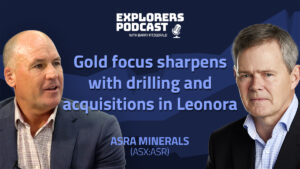Resources Top 5: Great timing — A lucrative gold mine reopens, just as new bull market threatens

Pic: Rudenkoi, iStock / Getty Images Plus
- “The Chatree mine is OPEN!” says freshly reminted gold miner Kingsgate Consolidated
- 3.4Moz mine to produce ~110,00ozpa over an initial 8-10 year life, at AISC of ~US$1,193/oz
- Asra Minerals (gold, REEs), Sabre Resources (nickel) Euro Manganese (manganese) up on no news
Here are the biggest small cap resources winners in early trade, Friday March 17.
KINGSGATE CONSOLIDATED (ASX:KCN)
“The Chatree mine is OPEN!” yelled the freshly reminted gold miner this morning.
A great result for the company which, for much of its life, was a success story on the ASX thanks to the prolific ~130,000ozpa Chatree mine in Thailand.
It enjoyed a share-price ride from $2.37 in late 2008 to $12.15 just two years later.
Since that peak it’s been a long downhill slide, partially thanks to a crappy gold price but especially thanks to the Thai government ordering the closure of Chatree in December 2016.
KCN challenged the closure of operations, and finally won.
The 3.4Moz mine will now produce ~110,00ozpa once fully ramped up over an initial 8-10 year life, at an all in sustaining cost of ~US$1,193/oz.
Ore will be initially sourced from low grade stockpiles before mining operations recommence in September 2023, the company says.
The $390m capped stock is flat year-to-date.
ASRA MINERALS (ASX:ASR)
(Up on no news)
The rare earths/gold/pastoral station-owning stock formerly known as Torian Resources admits it had a discouraging 2022.
A gold resource upgrade to 152,000oz at the Mt Stirling project was underwhelming and “personally disappointing” exec chair Paul Summers says. On the brighter side, it made a “remarkable” clay rare earths discovery at Mt Stirling.
“Yttria and Wishbone are truly unique discoveries due to their very high ratio of 0.62 heavy rare earths to total rare earths and the lack of radiation emitting nasties of Uranium (U) and Thorium (Th) prevalent in hard rock rare earth discoveries,” Summers says.
“In many ways, the company’s rare earth project stands out internationally from most rare earth projects.”
By October the REE footprint at Mt Stirling was 7.5km long and remained open in all directions.
New drilling results announced earlier this week hit more high grade heavy REEs at Yttria, including 7m @669ppm REE from 5m (76% HREO) and 70ppm scandium (including 1m @ 2182ppm TREYO from 7m).
Assays from a further 160 drillholes at Yttria are still outstanding and will be progressively reported in the coming weeks.
New drilling has already been prioritised, the company says.
Notably, Summer has said out loud what most clay REE stocks won’t – ASX explorers are still learning what makes an ionic clay deposit economic, with main producer China keeping its IP a closely guarded secret.
“There is little doubt as to the complexity of an understanding of REEs,” he says.
“We have espoused in the past as to the uniqueness of ASRA’s REE discovery, the lack of thorium and uranium, the regolith and shallow nature of the REE occurrences and the very high ratio of HREO to TREO so far unmatched.
“However, the learning process continues, as without an economic liberation of REEs the uniqueness of the occurrences means little.
“Unlike some discoveries being announced in the elevated hunt for REEs, ASRA has been very open with its entire data, revealing the extent and geochemical variability of its discovery, the path it has taken, and the direction forward.
“The past months have seen an extended period of gathering and understanding of data of which the new geological team have worked very hard to achieve and have arrived at an exciting turning point for the company.”
Refreshingly honest stuff. The $20m capped stock is down 40% year to date. It had $2.5m in the bank at the end of December.
EURO MANGANESE (ASX:EMN)
(Up on no news)
EMN owns the Chvaletice manganese project and is squarely focused on the emerging manganese battery market.
It plans to extract manganese rich tailings from a decommissioned mine in the Czech Republic and convert them into high purity manganese sulphate material for lithium-ion batteries.
Also listed in Toronto and Frankfurt, EMN announced its first offtake agreement in January 2022 in the form of a non-binding deal with Verkor, a low carbon battery manufacturer based in Grenoble in France, whose shareholders include Renault, Schneider Electric, Capgemini and Sibanye-Stillwater.
A 2022 feasibility study envisaged a 48,000tpa manganese production over a 25-year life making $554m revenues per year.
Of that, profit margins would be a lucrative 59%, the company said.
The biggest hurdle is a capex of $757m, but EMN is confident it will be a manganese miner by 2027.
The $90m capped stock is down 20% year-to-date.
METAL BANK (ASX:MBK)
(Up on no news)
MBK has advanced projects in WA and also North Queensland, a region that hosts several mammoth mines including Cracow (3moz), Mt Rawdon (2moz), Mt Morgan (8moz) and Gympie (5moz).
It has 51% (with the right to earn up to 80%) of Millennium, an advanced copper-cobalt-gold asset in Queensland with an existing 5.9Mt @ 1.08% CuEq across five granted mining leases.
There’s considerable potential to expand this, it says, with recent drilling pulling up high grade cobalt hits like 12m @ 0.62% Cu, 0.14% Co and 0.34g/t Au from 51m.
These grades “highlight Millennium as one of Australia’s highest grade undeveloped battery metals projects”, says MBK, which also believes mineralisation keeps going at depth.
Meanwhile, exec chair Inés Scotland has been in meetings over in the MENA (Middle East and North Africa) region in pursuit of copper assets in the Arabian/Nubian Shield.
Is there an acquisition on the horizon?
The $8m capped stock had $1.5m in the bank at the end of December, with an additional $2m loan provided by Scotland and fellow board member Sue-Ann Higgins late February.
SABRE RESOURCES (ASX:SBR)
(Up on no news)
SBR reckons there’s potential for a significant upgrade to the existing 110kt NiEq sulphide resource at the Sherlock Bay project in WA.
Great news for the junior, which already believes the project would already be lucrative at today’s nickel prices.
A Scoping Study completed in January 2022 highlighted “significant cash-flow potential” at a nickel price of US$10/lb (US$22,000t).
The LME nickel price, which has softened ~22% year-to-date, is currently ~US$23,000/t.
“The project economics of Sherlock Bay have already been shown to be cash-flow positive at a nickel price of US$10/lb,” SBR boss Jon Dugdale says.
“This would be significantly enhanced through further, higher-grade, sulphide discoveries on top of the more than 30% increase in the nickel price since the scoping study was completed – based on increased global demand for ‘future facing’ battery metals.”
Earlier this month SBR uncovered a second strong electromagnetic (EM) conductor massive sulphide target, 2km from the Discovery Zone resource.
Drilling of these targets is imminent.
“The detection of a second strong EM anomaly, this time on the southern contact of the Sherlock Intrusive 2km southwest of Discovery Zone, has further enhanced potential for additional massive sulphides and an upgrade to what is already a substantial mineral resource at Sherlock Bay,” Dugdale says.
“This, combined with planned metallurgical studies and further engineering work, will allow the company to fast-track a pre-feasibility study into a major new nickel sulphide development project, taking advantage of forecast future nickel and copper supply deficits and potential price increases.”
The $9m capped stock is flat year-to-date. It had $5.5m in the bank at the end of December.
Related Topics

UNLOCK INSIGHTS
Discover the untold stories of emerging ASX stocks.
Daily news and expert analysis, it's free to subscribe.
By proceeding, you confirm you understand that we handle personal information in accordance with our Privacy Policy.








